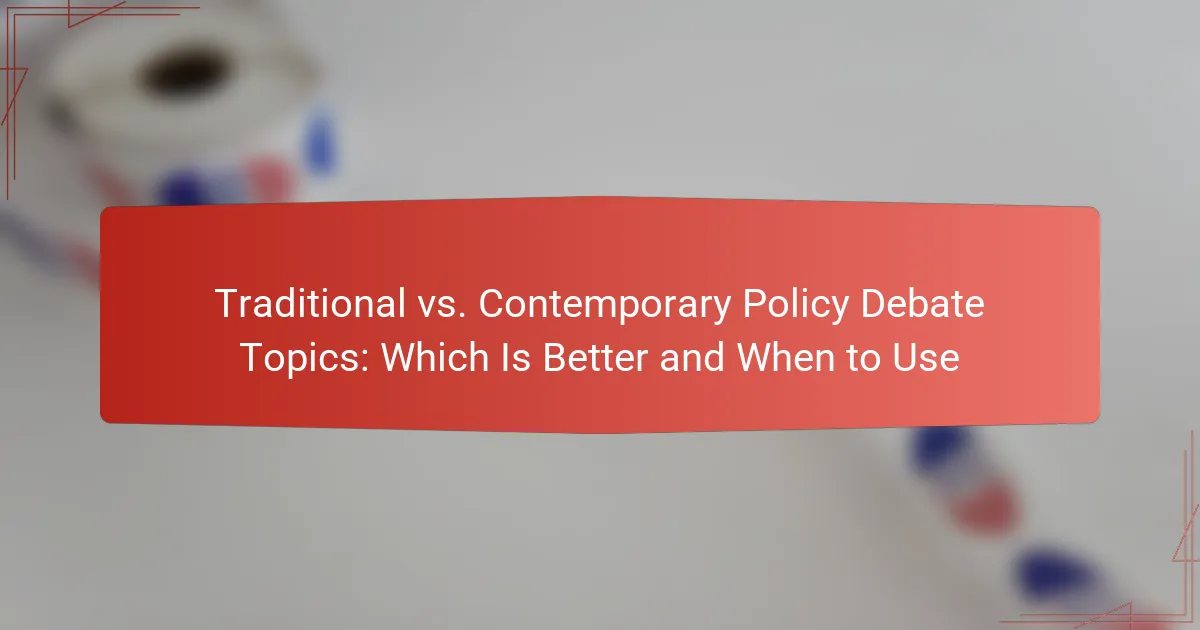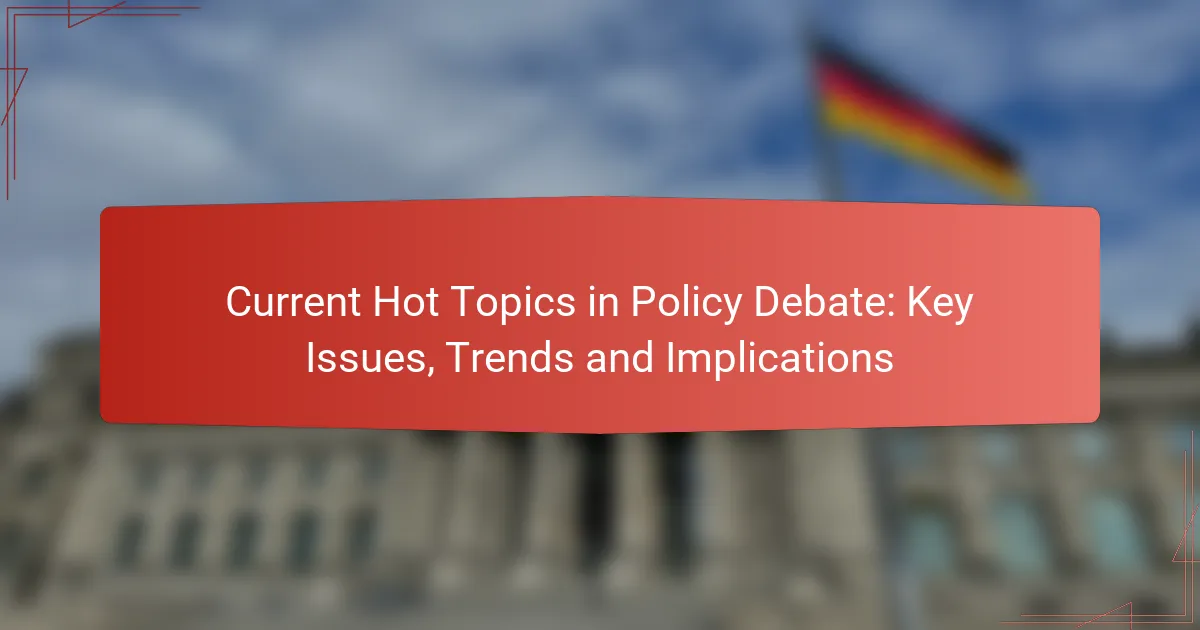In the realm of policy debate, traditional topics emphasize historical issues and established policies, while contemporary topics focus on current events and modern challenges. Choosing between these two approaches depends on the debate’s context and objectives, with traditional topics suited for structured environments and contemporary topics resonating more with today’s pressing societal issues.

What are the key differences between traditional and contemporary policy debate topics?
Traditional policy debate topics focus on long-standing issues often rooted in historical context, while contemporary topics address current events and modern societal challenges. Understanding these differences helps debaters choose the appropriate format based on the audience and objectives.
Focus on classic issues vs. modern relevance
Traditional policy debate topics typically revolve around enduring themes such as war, governance, and economic systems. These topics allow for deep exploration of historical precedents and theoretical frameworks.
In contrast, contemporary topics emphasize current events and pressing societal issues, such as climate change, healthcare reform, or technology regulation. This relevance can engage audiences more effectively and encourage discussions that reflect today’s challenges.
Structure and format variations
Traditional policy debates often follow a more rigid structure, including defined roles for each speaker and specific time limits for speeches. This format promotes thorough argumentation and rebuttal but may limit spontaneity.
Contemporary debates may adopt a more flexible structure, allowing for improvisation and adaptation to the flow of discussion. This can lead to dynamic exchanges but may require debaters to think on their feet and adjust their strategies quickly.
Judging criteria differences
Judging in traditional policy debates often emphasizes the depth of research, clarity of argumentation, and adherence to established formats. Judges look for well-supported claims and logical reasoning based on historical context.
In contemporary debates, judges may prioritize relevance and the ability to engage with current issues. They often assess how well debaters connect their arguments to real-world implications and the effectiveness of their communication style.
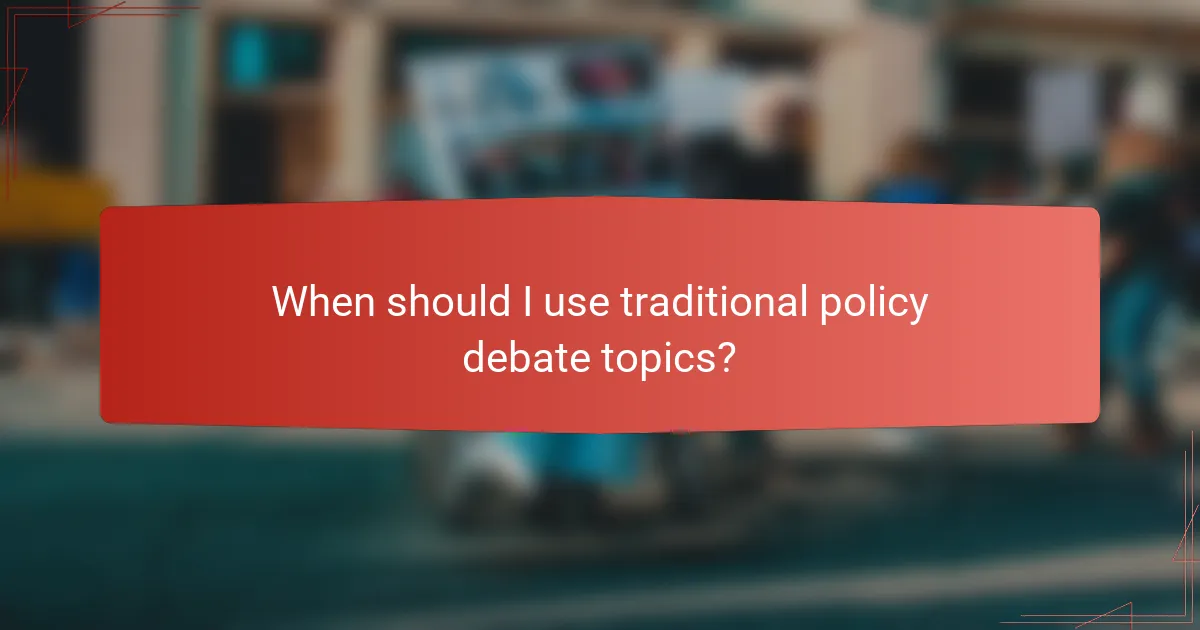
When should I use traditional policy debate topics?
Traditional policy debate topics are best used in settings where structured argumentation and historical context are prioritized. They provide a framework for exploring established policies and their implications, making them suitable for formal debate formats.
Historical context relevance
Traditional policy debate topics often draw on historical issues, allowing debaters to engage with the evolution of policies over time. This context helps participants understand the implications of past decisions and their relevance to current debates. For example, topics related to healthcare reform can reference historical legislation like the Affordable Care Act.
Educational settings
In educational environments, traditional policy debate topics are frequently employed to teach critical thinking and research skills. They encourage students to analyze existing policies and develop well-rounded arguments. High school debate teams often use these topics to prepare for competitions, as they align with standardized debate formats.
Specific audience engagement
When addressing audiences familiar with specific policy issues, traditional topics can enhance engagement by providing relatable content. For instance, debates on environmental regulations resonate well with audiences concerned about climate change. Tailoring topics to the interests of the audience can lead to more dynamic discussions and increased participation.
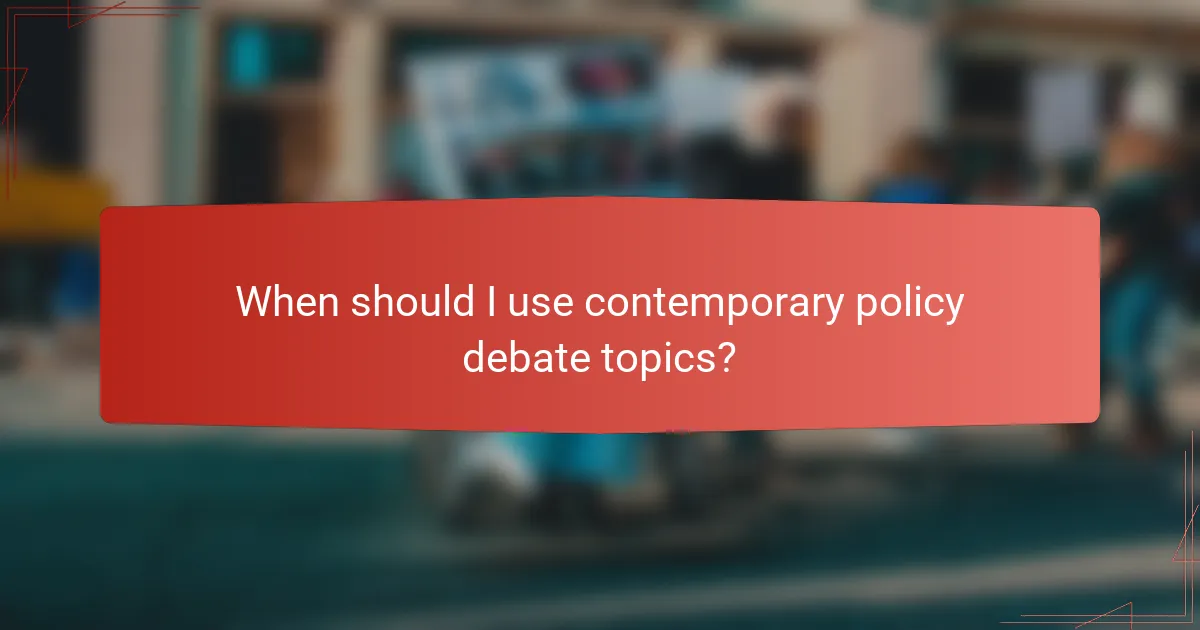
When should I use contemporary policy debate topics?
Contemporary policy debate topics should be used when relevance to current events and societal issues is essential. These topics engage participants and audiences by addressing pressing matters that resonate with today’s world.
Current event relevance
Contemporary policy debate topics often focus on issues that are currently in the news or public discourse, such as climate change, healthcare reform, or digital privacy. This relevance helps debaters connect their arguments to real-world situations, making their discussions more impactful and relatable.
Using topics tied to current events can also attract media attention and public interest, enhancing the visibility of the debate. For example, a debate on the implications of social media regulation can spark conversations that extend beyond the debate itself.
Engagement with youth audiences
Youth audiences are more likely to engage with contemporary policy debate topics because these issues directly affect their lives and futures. Topics like education reform or mental health awareness resonate with younger participants, fostering a deeper connection to the material.
To maximize engagement, consider incorporating popular culture references or recent events into the debates. This approach can make discussions more dynamic and relatable, encouraging active participation from younger debaters.
Adaptation to modern issues
Contemporary policy debate topics allow for the exploration of modern issues that traditional topics may overlook. Issues such as artificial intelligence ethics, global pandemics, and systemic inequality are crucial for understanding today’s challenges.
When selecting topics, aim for those that encourage critical thinking about future implications and solutions. This not only enhances the educational value of the debate but also prepares participants to tackle complex problems in their communities and beyond.
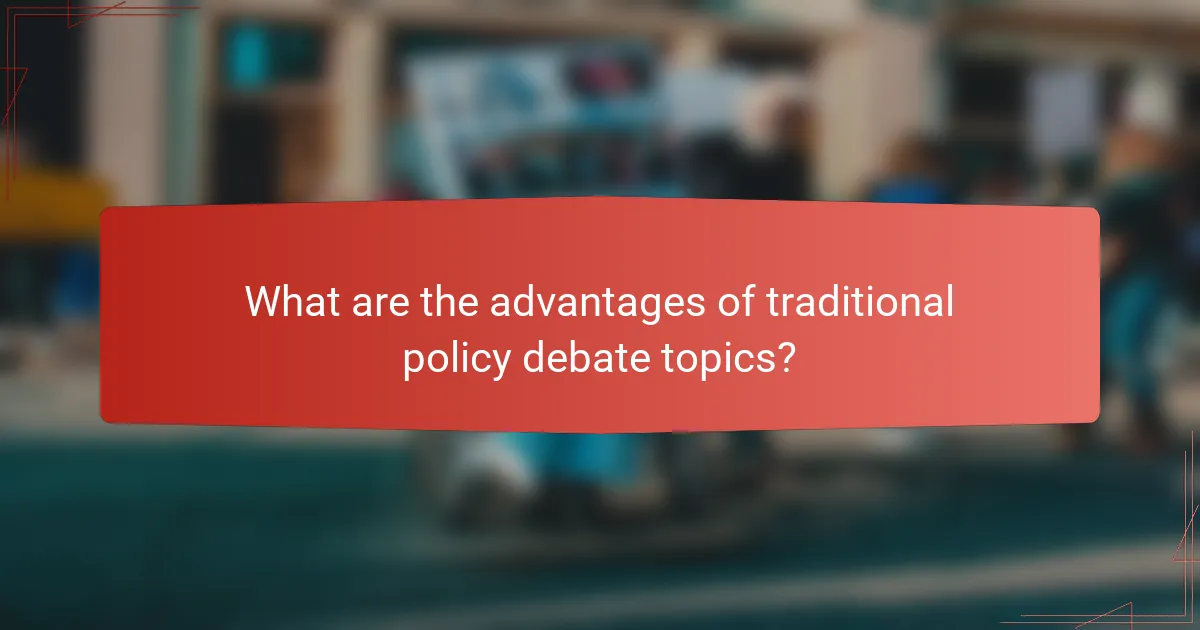
What are the advantages of traditional policy debate topics?
Traditional policy debate topics offer a structured environment that encourages rigorous argumentation and critical thinking. They typically focus on specific policy proposals, allowing debaters to engage deeply with established issues and frameworks.
Established frameworks and formats
Traditional policy debate topics come with well-defined structures that guide participants through the debate process. These formats often include specific time limits for speeches and rebuttals, which help maintain order and clarity. Familiarity with these frameworks allows debaters to focus on content rather than logistics, making it easier to prepare and participate effectively.
Depth of research opportunities
The specificity of traditional policy topics enables debaters to conduct extensive research on particular issues. This depth allows for a thorough exploration of the topic, including historical context, current implications, and potential outcomes. Debaters can utilize a variety of sources, such as academic journals, government reports, and expert opinions, to build strong, evidence-based arguments.
Historical significance
Traditional policy debate topics often revolve around issues with significant historical context, providing a rich backdrop for discussion. Understanding the history of a policy can enhance arguments and allow debaters to draw parallels with contemporary issues. This historical perspective not only enriches the debate but also helps participants develop a more nuanced understanding of the policy landscape.
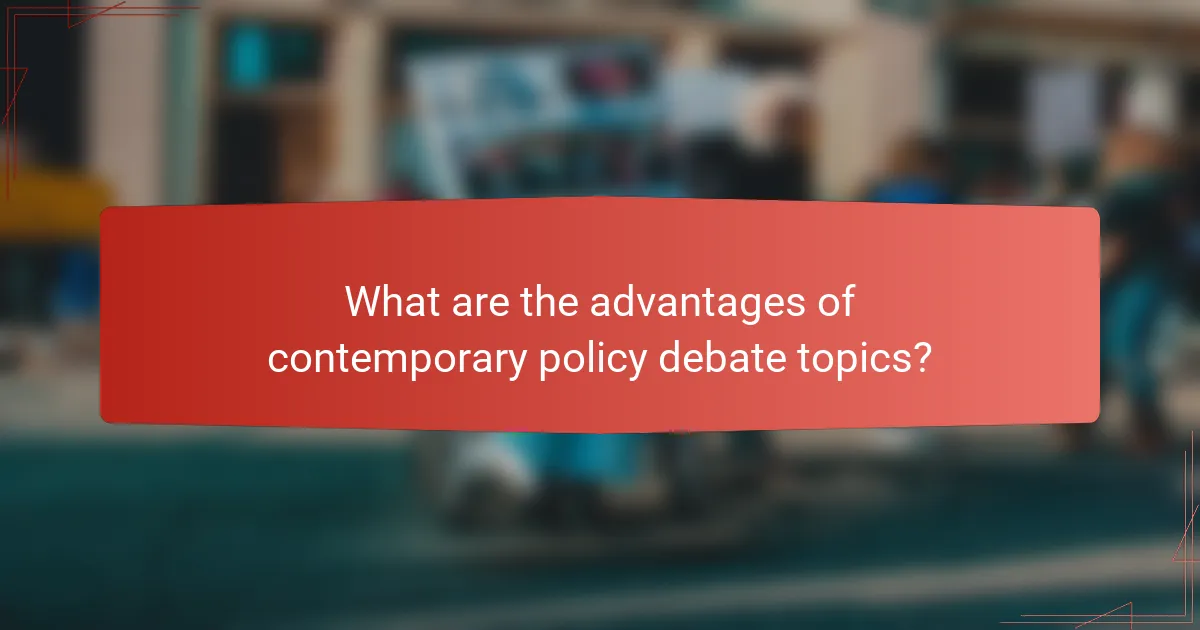
What are the advantages of contemporary policy debate topics?
Contemporary policy debate topics offer several advantages, primarily their relevance to current events and issues that resonate with today’s society. These topics encourage debaters to engage with pressing matters, fostering critical thinking and informed discussions.
Relevance to current affairs
Contemporary policy debate topics are closely tied to current affairs, making them highly relevant for participants and audiences alike. Debaters can explore issues such as climate change, healthcare reform, and social justice, which are at the forefront of public discourse.
This relevance not only enhances the engagement of participants but also allows for a deeper understanding of the complexities surrounding these issues. Debaters are encouraged to stay informed about the latest developments, which can enrich their arguments and perspectives.
Flexibility in topic selection
Contemporary topics provide flexibility in selection, allowing debaters to choose issues that resonate with their interests and expertise. This flexibility can lead to more passionate and informed debates, as participants are likely to be more invested in topics they care about.
Moreover, the dynamic nature of contemporary issues means that topics can be updated or adjusted to reflect ongoing changes in society, ensuring that debates remain fresh and engaging. This adaptability is crucial for maintaining interest in the debate format.
Broader appeal to diverse audiences
Contemporary policy debate topics tend to have broader appeal, attracting diverse audiences who may have varying perspectives on the issues. This inclusivity can lead to richer discussions and a more comprehensive exploration of the topic at hand.
By addressing issues that affect different demographics and communities, contemporary debates can foster dialogue among participants and spectators from various backgrounds. This can enhance understanding and empathy, making debates not just competitions but also platforms for social discourse.
